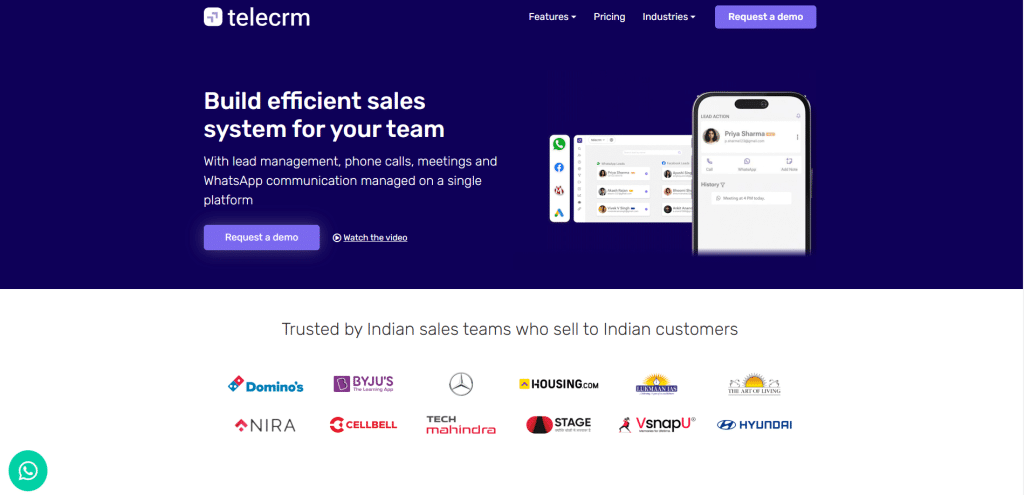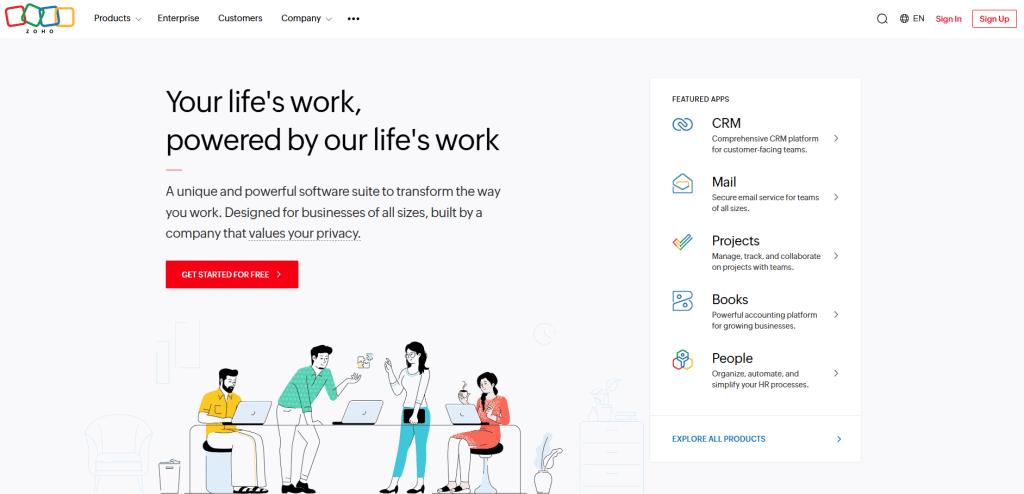
Does contact management involve dealing with only lead information or does it include all stakeholders?
What exactly is the scope of contact management?
Is a contact management system concerned with just organising contact information or does it also help manage prospect and customer relationships?
If any of these questions are on your mind, this article is for you! And not just that, we’ll also discuss the difference between a contact management system and a CRM, its notable features and how you can choose the best contact management system for your business.
First of all, what/who is a ‘contact’? Well, any lead, prospect or customer your brand interacts with to sell, upsell or cross-sell your product or service is considered a contact.
And there’s a good chance you may be already engaged in contact management for your business because otherwise, your business won’t be a business.🤷♂️
So contact management is:
Neatly organising all contact data in one single repository
Interacting with leads and customers
Tracking customer preferences through detailed records of their interactions with your business
Ensuring that your prospects become your long-time customers
Retaining those customers by providing top-notch user experience
We’re pretty sure you carry out most of these activities at work. But are you doing them effectively? Keep reading to find out!

Your team probably manages 10s and 100s of contacts every single day, through hefty physical registers or Excel spreadsheets. You might be able to record all this information but you’ll never be able to manage it effectively because:
Registers and spreadsheets don’t track interactions, only information
It’s messy and your team will have to go through heaps and heaps of data just to find the right contact
You might end up targeting the wrong contact because everything is just a long list of rows of columns and finding the right contact is difficult
Now as the saying goes, contact is king (sorry, not sorry) and you can’t afford to lose track of follow-ups, their preferences, their buying status, etc.
The perfect solution to these problems is a contact management system. It is a tool designed to organise, manage and track contacts throughout the entire sales cycle. So whenever you get a new lead in your system or a customer purchases your product, a CMS records every little detail in one place.
“I understand that CMS could be useful to my business but do I need it?” is what you’re probably asking right now.
Well, you can probably manage your contacts without the help of tech, but can you:
Track past interactions including phone calls and messages to follow-ups to every minor interaction effectively through your existing manual system?
Personalise customer experiences by understanding their preferences and dislikes?
Interact with prospects and customers through phone calls, emails or WhatsApp from one place?
Assess how your sales strategies are performing?
Secure all contact details and manage them from one dashboard?
Even if you can do all this, we bet it’s not as effective as it’d be with contact management software.

If you google ‘best contact management software’ you’ll probably end up getting a laundry list of top CRMs (customer relationship management). So essentially, CRM and CMS are the same.
But definition-wise, they differ. Contact management systems are normally concerned with organising contact information securely while a CRM does both; organise contacts and manage customer relationships.

If you’ve read this far, you should also get to know the features that you need to look out for in a contact management solution.
Create custom fields and save essential contact details — names, addresses, phone numbers, emails and anything else you fancy capturing into the system! All of that information will be stored in one place. So, no more scattered information or lost details. Every piece of information about the contact remains safe and sound in one easily accessible place.
And since it’s a repository of all your contacts, you can track customer interactions from within the CMS itself.

Segment contacts based on customer data, including purchase history, demographic characteristics such as , age, gender, location, education, income, etc. This helps you quickly locate the exact information you need without sifting through endless lists.
You can even use the CMS as a tool to boost your sales and marketing efforts. Yes, by segmenting contacts according to demographics and/or other criteria, you can improve your targeting efforts.

Contact management tools like Telecrm, Monday and Pipedrive are not just for contact management but are complete call management software as well- you can make calls, schedule emails and send WhatsApp messages directly from within the system. The best part? These platforms let you handle all communication from one central hub, making it easier to keep track of every interaction.

Import contacts from various sources like CSV files, your website and third-party tools directly into the CMS. This ensures your contact list is always up-to-date and comprehensive, without the need for any heavy lifting by you or your team.
In a contact management system, you can assign user roles and permissions to control who can access or edit contact information. This keeps your data secure and ensures that only authorised personnel can make changes, reducing the risk of errors and unauthorised access.
Using rotating proxies also improves security by masking your IP address and preventing malicious attacks.

Generate customisable reports on trends, contact conversion rates, sales numbers, customer retention and more. These insights provide valuable information on how your business is performing and help you make informed decisions to drive growth.
Automate repetitive tasks like sending follow-up notifications or updating contact information. This not only saves time but also ensures consistency and accuracy in your interactions, allowing you to focus on more strategic activities.

Now that you’ve more or less made up your mind about getting a contact management solution for your business, this is what you should do next:
Start by understanding what you need from a CMS. Are you looking to simply organise contact information or do you need features like interaction tracking, automated reminders and reporting? List down your must-have features.
Nobody wants to spend extensive time getting used to a new software. Make sure the CMS is user-friendly. Your team should be able to navigate the system without extensive training. A complicated system will just compound the stress and reduce productivity. Look for a clean, intuitive interface.
Every business is unique. The best CMS allows you to customise fields and workflows according to your specific needs. Whether it’s adding custom fields or creating specific tags for contacts, flexibility is key.
Your business will grow, and so should your CMS alongside it. Choose a system that can handle an increasing number of contacts and interactions without compromising on performance.
Data security is paramount. Ensure the CMS provides robust security measures, such as user roles and permissions, encryption and secure data storage. This keeps your information safe from unauthorised access and protects your brand from any unwanted crisis. Adding insider fraud prevention measures can also help catch and prevent any potential threats from within your organisation.
Moreover, consider using datacenter proxies on top of all your security measures to enhance the security of your organisation’s online activities.
Bad customer support is a headache, especially when you’re integrating new software for the very first time. So make sure the customer support is available 24/7 for you to get used to the software. Look at software review sites to get an idea.
Pro Tip: Before committing, take advantage of free trials or demos. This allows you to test the CMS in real-world scenarios and see if it meets your business requirements. Make sure the system is just as good in practice as it is on paper.
Focus on value-for-money solutions rather than looking for an affordable contact management platform that may or may not fulfil all your business needs. In other words, don’t buy a system that you’d need to replace after a few years.
Now that you have finally decided to implement a contact management software in your business, we have curated a list of the top 6 options for your business to choose from:

Telecrm is a WhatsApp-based sales CRM designed in India for small and medium businesses. It allows unlimited contact storage, seamless pipeline management and centralised tracking of every customer interaction.
HubSpot is a cloud-based CRM that offers an all-in-one solution for contact management, marketing, sales, content management and customer service. It seamlessly integrates social media and landing pages with comprehensive contact tracking.
Pipedrive is renowned for its visual sales pipeline and intuitive dashboards. It excels in pipeline management while offering detailed contact profiles and interaction tracking.
Freshsales by Freshworks offers a unified suite for sales, marketing and customer support, featuring a free plan ideal for small teams.
Monday Sales CRM offers an intuitive, visual platform for managing contacts, interactions and workflows. It integrates seamlessly with marketing, project management and development tools.

Zoho CRM is a comprehensive ERP suite that caters to sales optimisation, customer support and contact management. It also offers Bigin — a cost-effective solution for small businesses.

In this article, you’ve learned what contact management is and its various use cases. If you aren’t already using contact management software, it’s about time you do!
Understand the scope of contact management in your business and then find the appropriate solution using our checklist above. Or you can save yourself the trouble and consider getting Telecrm — a sales-based CRM software loaded with all the features you’ll ever need! And guess what – it’s made in India.
Visit our homepage today to know more!


© Copyright 2025 Telecrm.in - All Rights Reserved • Privacy Policy • T&C


© Copyright 2025 Telecrm.in - All Rights Reserved • Privacy Policy • T&C